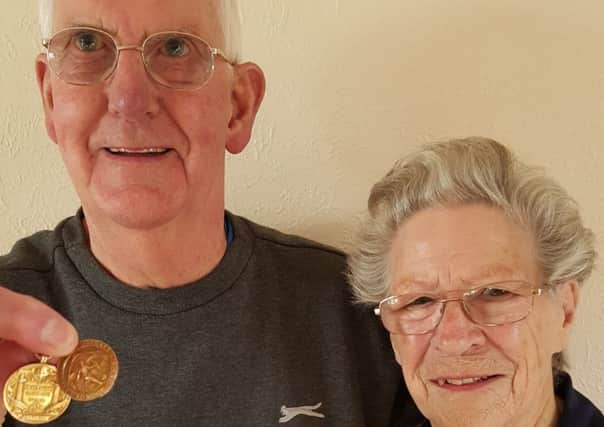STAGS NOSTALGIA: Christmas challenge for former Stag Nobby Clarke, who became a Palace legend


As Mansfield couple Denis and Betty Ball prepare for Christmas, Betty recalled how it was for her family when father George Clarke was a free-scoring left winger at Crystal Palace.
The ex-Mansfield Town player is a pre-war legend at Selhurst Park, but she said: “At that time he was earning about £8 a week.
Advertisement
Hide AdAdvertisement
Hide Ad“They had to win the game before Christmas to get a Christmas chicken or duck as a bonus. If they didn’t win, they got nothing, not even for a draw.”
A miner at Welbeck Colliery, he began his career with the colliery side in the Central Alliance.
He then kicked off his professional career with two seasons at Stags before he moved to Aston Villa for £500 and then on to Palace for £300.
Bolsover-born Clarke played 299 games for Palace between 1925 and 1933 and carved his name there into legend.
Advertisement
Hide AdAdvertisement
Hide AdA left winger, he scored 106 goals – leaving him the third highest-placed League goalscorer in the club’s history.
Clarke’s displays for the Midland League Stags had attracted the attention of Villa midway through his second season at Field Mill in December 1922. Some records state he moved for a fee of £350 and some £500, but either way it was a hefty fee for a non-League player at that time.
“He struggled to make it into the Aston Villa side as their left winger was also the England left winger,” said Denis.
“He was only there a year (playing once), then the chairman of Aston Villa bought Crystal Palace, and dad went with him and spent just under 10 years there.”
But what a 10 years it proved to be.
Advertisement
Hide AdAdvertisement
Hide AdHe sits equal fifth in the club’s FA Cup goalscorers chart with seven goals and also fifth in the club’s all-time FA Cup appearances with 25 appearances.
He is fourth in the club’s all-time top League scorers chart on 99 (1925-33), one place and four goals ahead of current Forest boss Dougie Freedman and one goal and one place behind Clinton Morrison, still plying his trade at Exeter City.
On overall first team goals he scored 106, making him seventh behind Freedman (108) in sixth and Morrison (11) in fifth. Peter Simpson leads the way with 165 (top League scorer also with 153).
He holds the record of the highest number of goals scored in a single season for a winger.
Advertisement
Hide AdAdvertisement
Hide AdThe Men Who Made Crystal Palace, a book celebrating former players, stated: “He was a magnificent winger - a ball player with craft and artistry – but also fast, clever and with a lethal shot, so his name is etched for all time into the Palace record books.”
The Rev Nigel Sands, the club’s official historian and statistician, said: George ‘Nobby’ Clarke was a magnificent player, a ball player but fast, clever and with a lethal shot, whose prowess has etched his name.
“George Clarke was a pillar of the Palace side for seven seasons from 1925 – he had an ordinary name, but he was no ordinary footballer.”
During the Second World War he was in a reserved occupation in Croydon and served with the Home Guard. He was also a keen cricketer.
Advertisement
Hide AdAdvertisement
Hide AdDennis said: “In the summer months there was no money, so he played cricket.
“It was for local clubs in Croydon, but they got paid. After he retired he came back up to Mansfield because that was where the roots were.”
Some of the records suggest Clarke moved on from Palace to QPR and finally Folkstone, but his daughter has no recollection of that.
“We don’t think he went to Folkestone or Queen’s Park Rangers,” she said. “As a child I can’t remember him ever travelling to either. When he retired from Crystal Palace we lived down there until he was 65.
Advertisement
Hide AdAdvertisement
Hide Ad“I do remember when I was at school, with him being at home in the mornings, he used to take me to school.”
Despite the years going by, Clarke is warmly remembered at Palace and in 2005 Betty and Dennis were invited to Selhurst Park for the clubs’ Centenary.
“When it was the Palace Centenary, they invited us and any of our family who wanted to go down,” recalled Denis.
“We were in the box with the directors and we watched the game against Preston North End.
Advertisement
Hide AdAdvertisement
Hide Ad“At half-time Betty and I went into the centre of the pitch and they introduced us as Betty is the only living relation, other then our grandsons and granddaughters. They introduced her and she got a great response.
“Afterwards we met the players, the directors and other people, Dougie Freedman was there then.”
Not long after they were back down there again after learning George had been honoured by having a Croydon street named after him.
“About three years ago they invited us down for a match at the end of the season as we wanted to go and see his name on the avenue,” said Denis.
Advertisement
Hide AdAdvertisement
Hide Ad“We didn’t know that had happened. They didn’t ask us for permission because they didn’t think anyone was alive that would be able to attend.
“We had a tour around and found it as Betty knows a bit about Croydon. It is a private estate with gates on either side.”
Clarke returned north after his playing career ended, working for the Electricity Board, and died aged 76 in 1977 after failing health for his last seven years.